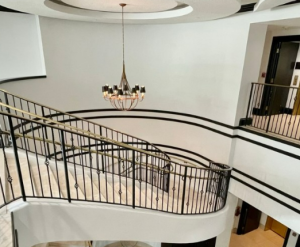How Can I Maintain My Home’s Paint Job Longer in Florida’s Climate?





 A fresh coat of paint can make your home look stunning—but in Florida’s intense climate, that vibrancy and protection can fade faster than you’d expect. Between blistering sun, pounding rain, high humidity, and salty coastal air, exterior paint jobs in Palm Harbor face serious environmental challenges. So, how can you extend the life of your investment and keep your home looking great for years to come? The answer lies in proper maintenance, smart choices, and working with an experienced Painter who understands Florida’s unique demands.
A fresh coat of paint can make your home look stunning—but in Florida’s intense climate, that vibrancy and protection can fade faster than you’d expect. Between blistering sun, pounding rain, high humidity, and salty coastal air, exterior paint jobs in Palm Harbor face serious environmental challenges. So, how can you extend the life of your investment and keep your home looking great for years to come? The answer lies in proper maintenance, smart choices, and working with an experienced Painter who understands Florida’s unique demands.
In this comprehensive guide, we’ll explore the best practices for maintaining your home’s paint job—inside and out—so you can protect your property, extend the lifespan of your paint, and maximize curb appeal in every season.
Why Florida’s Climate Is Tough on Paint
Before diving into maintenance strategies, let’s understand the forces at work:
☀️ UV Radiation
Florida’s year-round sunshine is a double-edged sword. While it keeps things bright and beautiful, UV rays break down pigments and resins, causing color fading, chalking, and cracking.
🌧️ Humidity and Rain
Palm Harbor’s rainy season delivers heavy, frequent showers. Moisture can seep under paint layers, especially if surfaces weren’t sealed properly, leading to bubbling, mold, and peeling.
💨 Salt Air
If you live near the coast, salt carried on the breeze accelerates corrosion and surface deterioration, particularly on metal fixtures and porous surfaces like wood and stucco.
🌡️ Temperature Fluctuations
Heat and humidity cause building materials to expand and contract, creating hairline cracks in paint and reducing adhesion over time.
How Long Should Paint Last in Florida?
With proper application and maintenance:
- Exterior paint on stucco: 8–10 years
- Wood siding or trim: 5–7 years
- Interior paint: 7–10 years, depending on room use and quality
- High-humidity areas (bathrooms, kitchens): 3–5 years
Your goal? Make those maximum timelines a reality by being proactive with upkeep.
1. Choose the Right Paint from the Start
Maintenance starts before the paint even touches the wall.
Use Climate-Specific Products:
- 100% acrylic latex for breathability and flexibility
- Elastomeric coatings on stucco or masonry to bridge cracks
- UV-resistant and fade-resistant formulas
- Mildew-resistant additives for humid zones
Professional Painters in Palm Harbor often recommend brands like Sherwin-Williams Duration®, Behr Marquee®, or Benjamin Moore Aura®—all proven to hold up in Florida’s climate.
2. Wash Your Exterior Annually
Mold, mildew, algae, and dirt build up quickly in Florida. An annual pressure wash or soft wash is one of the most effective ways to keep your paint looking fresh.
Tips:
- Use a gentle solution of water and mild detergent
- For stubborn mildew, use a mix of water and white vinegar
- Hire a pro for multi-story homes or delicate surfaces
Avoid using high PSI on painted wood or stucco—it can do more harm than good. If unsure, consult a professional soft washing service.
3. Trim Plants and Trees Regularly
Overgrown vegetation can trap moisture against your siding and accelerate mildew and paint degradation. It can also scratch painted surfaces and provide shade that fosters algae growth.
Best Practices:
- Keep bushes at least 12–18 inches away from your home
- Trim trees to prevent leaves from pressing against the exterior
- Remove vines and moss as soon as they appear
Keeping your landscaping tidy also improves airflow and drying around your home’s surfaces.
4. Touch Up Early, Not Late
Don’t wait until cracking or peeling spreads. Minor damage is easier and cheaper to fix if caught early.
Look for:
- Fading or chalking on sun-exposed walls
- Small paint bubbles or cracks
- Peeling at window sills or corners
- Water stains or rust on trim and flashing
Keep a small amount of your original paint stored in a cool, dry place so you can quickly perform touch-ups when needed.
5. Inspect for Water Damage and Leaks
Even the best paint can’t protect a home from water intrusion forever. Regularly inspect:
- Gutters and downspouts for clogs or overflow
- Roof edges and soffits for signs of leaks
- Caulking around windows and doors
- Wood trim or fascia boards for softness or rot
Fixing leaks promptly prevents paint from separating and prevents mold from forming beneath the surface.
6. Re-Caulk and Seal Joints Every 2–3 Years
Caulking is your paint’s support system. Over time, it can dry out, crack, or pull away from surfaces—especially with Florida’s heat expansion and moisture cycles.
Focus on:
- Window and door trim
- Gaps between siding and fascia
- Seams where materials meet (brick and wood, for example)
Use a high-quality, paintable exterior-grade silicone or polyurethane caulk, and always reseal before applying a fresh coat of paint.
7. Keep Interior Walls Clean and Dry
Interior paint lasts longer when walls are kept clean and dry—especially in high-use areas like kitchens and bathrooms.
Pro Tips:
- Wipe walls with a soft, damp cloth or sponge once per season
- Use bathroom fans during and after showers
- Avoid harsh chemical cleaners (they can dull your finish)
- Use scrubbable paints in high-traffic areas
If you notice discoloration or bubbling indoors, it may indicate an insulation or moisture issue—don’t ignore it.
8. Schedule Professional Inspections Every Few Years
Even if you don’t plan to repaint soon, it’s wise to have a Painter inspect your home every 3–5 years. They’ll assess:
- Surface integrity
- Paint film condition
- Hidden issues (mold, insect damage, rot)
- Areas that need reinforcement or resealing
A trained eye can spot trouble before it escalates—and help extend your paint job’s lifespan without a full redo.
9. Stay on Top of HOA Requirements
If you live in a neighborhood with an HOA, regular maintenance also keeps you in compliance with community standards. Most HOAs expect homeowners to maintain:
- Uniform color appearance
- No visible peeling or fading
- Trim and doors in clean, painted condition
Staying ahead of these standards not only avoids fines—it also preserves neighborhood property values.
10. Plan for Repainting Before It’s Urgent
Don’t wait until paint is falling off the house. If your paint is:
- Fading significantly
- Cracking at joints
- Looking dull despite cleaning
…it’s time to plan a repaint. A fresh coat applied before complete failure means less prep work, lower costs, and better results.
Final Thoughts: Paint Maintenance Is Climate Armor
Florida’s beautiful scenery comes with some tough weather challenges—but with proactive maintenance, your paint job can hold strong for years. Regular washing, sealing, inspections, and touch-ups are simple steps that pay big dividends in preserving your home’s beauty and value.
Partnering with a trusted Painter ensures you’re not just painting for looks—but for long-term protection, comfort, and curb appeal. Your home deserves it—and so do you.
Coming Up Next:
Thinking about repainting soon? Don’t overlook the foundation of any lasting job. In our final blog of the series, we’ll answer Does My Palm Harbor Home Need Primer Before Painting?—a guide to when (and why) primer is crucial in Florida’s climate.

100% Satisfaction Guarantee

Licensed and Insured

Color Consultation

3 Year Warranty
Services

Our team of experts does popcorn ceiling removal and wallpaper removal. We also do drywall and stucco repairs as well as texturing, soffit and fascia repair.
Painting Service Locations

How long does it take to paint my house?
What is included with your free estimate?
All of our estimates include a fully detailed scope of the work to be completed. You will receive a report with a breakdown of the cost and time estimated for your project.
How do I get my project scheduled?
Simply follow the steps in the estimate to schedule or give us a call, text, or email. Whichever is convenient for you works for us.
Why does a house have to be pressure washed before painting?
If you’re planning to paint the exterior of your home, you may be wondering why pressure washing is such an important step. After all, a little dirt and grime shouldn’t stop the paint from sticking, right? Unfortunately, it’s not that simple. Over time, dirt, mildew, and other pollutants can build up on the surface of your home, causing the paint to chip and peel. Pressure washing removes this build-up, giving the new paint a clean surface to adhere to. In addition, pressure washing also helps to remove any chalky residue left behind by old paint. This ensures that the new paint will have a smooth, even finish. For these reasons, it’s always best to have your home professionally pressure washed before painting
Item How often does a house need to be repainted?
The frequency with which a house exterior needs to be repainted depends on a number of factors, including the type of paint used, the climate, and the level of exposure to sun and rain. In general, however, most experts recommend repainting every three to five years. High-quality paints that are properly applied can last for about 10 years, while lower-quality paints may last less. The climate also plays a role in how often a house needs to be repainted. For example, homes in areas with high humidity levels may need to be repainted more frequently than homes in dry climates. Exposure to sun and rain can also shorten the lifespan of paint, so homes that are exposed to these elements may need to be repainted more often than those that are not. Ultimately, the best way to determine how often a house exterior needs to be repainted is to consult with a painting contractor who can assess the condition of the paint and make a recommendation based on individual circumstances.
Trustindex verifies that the original source of the review is Google. I want to thank Curb Appeal Pros for doing an amazing job of painting the exterior of my house. Sending a big shout out to owner, Jay McGarrity, for being so patient, professional, and fair with the pricing, timing, and color choices. When I changed my mind about the original colors that I had selected, Jay came back to my house twice (including Father's Day) to test some different paint samples I had purchased from Sherwin Williams. The final result was exactly what I wanted and my house looks fabulous! I will hire Curb Appeal Pros again when I am ready to have some interior painting done.Trustindex verifies that the original source of the review is Google. They repaired stucco on the fireplace exterior and outside window sills, pressure washed the house, and my shed in the backyard. Painted the house and all fascia and soffits. They did an outstanding job !! Would not hesitate to use them again.Trustindex verifies that the original source of the review is Google. Amazing job filled in all the settling cracks and made the house look amazing would highly recommend them to anyone who’s looking to fix their home up.Trustindex verifies that the original source of the review is Google. What a great experience. Joey worked with me to get the house painted in between projects so I could have the house painted before my new gutters were put in. I didn't have to be home, which was a plus. The painter Angel and Nathen which I got meet at the end of the project were friendly and professional. I would definitely recommend Curb Appeal. Joyce Walter.Trustindex verifies that the original source of the review is Google. We recently hired Curb Appeal Pros to paint our living room,dining room, family room and kitchen. They were easily up to the task. I had different colors,different paint finish’s, texturing and an accent wall as well. Angel and his crew did an amazing job.They were organized ,pleasant ,and had my entire house finished in less than 3 days. They removed all the large furniture and carefully put it back in its place perfectly after the job was done ! The owner was hands on and was easy to reach and made sure that my questions were answered without delay or hesitation. My house looks amazing . They went the extra mile in every way and we are so grateful . Thank you Curb Appeal for a job well done. I recommend you contact them for all your painting needs.Trustindex verifies that the original source of the review is Google. Curb Appeal Pros is a 'one stop shop'. They recently painted our house and installed ledger stone on the exterior of our house. After the job was completed, we contacted Jay McGarrity about a detail. Jay immediately responded and came back to the house even after payment! The end result of their work is beautiful. Jay and his Team are a pleasure to work with.Trustindex verifies that the original source of the review is Google. reliable, great work, honest pricing. i highly recommend these pplTrustindex verifies that the original source of the review is Google. Fair price and good work. What more can you ask for?Trustindex verifies that the original source of the review is Google. Excellent job. Jay was quick to respond to everything we asked, kept us well informed and made sure the job was done exactly how we asked. Will definitely recommend to everyone who asks, which we have already done several times as of this review. Truly thankful for the professionalism when so many companies now lack it!
Request An Estimate

copyright @2025 all rights reserved | Privacy-policy